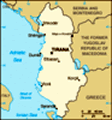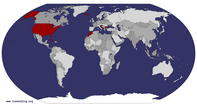Advertisement
Published: June 21st 2018
In May, 2017, we spent 2 weeks with a tour group in the Balkan countries which lie along the magnificent, deep blue Adriatic Sea -- Albania, Montenegro, a tiny bit of Bosnia-Herzegovina, Croatia and Slovenia. Since other destinations ranked higher on my wish list, I'm not quite sure why we decided to do this particular trip. However, now reflecting back on our experiences and observations, I can say enthusiastically that I'm extremely glad we chose to do this Balkan trip! It was particularly interesting to visit these countries now as they still might be considered democratic government fledglings. Most of these countries have become sovereign nations relatively recently and one, Albania, in my opinion, is still in the process of emerging from being ruled under a long-term dictatorship.
Taken as a whole the trip was terrific, exhausting, educational and fun --- the culture and customs, the geography, the history, sights and activities were varied and interesting -- and the experience far exceeded our expectations! A significant amount of the credit for this goes to our excellent guide, Edo Poljarevic. Group tours often have drawbacks, but we experienced very few on this trip.
Flying with Austrian Airlines from the east
coast of the US, we had a few hours layover in Vienna before continuing on to Tirana, Albania, but not enough time to leave the airport. From Vienna, our flight to Tirana was only 1.5 hrs. We touched down at Rinas International Airport, now referred to as Tirana International Airport Nënë Tereza (Mother Theresa). The airport was well organized, and passing through customs and passport control went smoothly and quickly. Edo, our guide, was waiting for us.
During the trip, we crossed no fewer than 5 official, gated country borders traveling from Albania to Slovenia -- an experience which required patience and sometimes a small, non-monetary bribe. Road travel is often exciting and this trip was no exception. It’s not an overstatement to say that our tour route so closely followed the twists and turns of the Adriatic coast for nearly the whole trip that we rarely traveled a straight road! We visited a variety of landscapes including the higher regions of Albania, the lush green mountains of Montenegro, the mesmerizing turquoise pools and waterfalls of Plitivice Lakes in Croatia, the incredible Postojna Caves and the mirror-like Bled and Bohinj Lakes in Slovenia -- all of it scenic and
always interesting.
This was an active trip and we averaged walking 3 miles or significantly more every day, and there was a great deal of uphill climbing and an innumerable amount of steps, and staircases to surmount. Following our overnight flight and arrival in Tirana, on Day 2 we checked in at the
Rogner Hotel, a beautiful hotel located on
Dëshmorët e Kombit Boulevard in the heart of the city. Our room overlooked the Mediterranean Garden and the lovely pool. The meals we had here were excellent and the staff was very accommodating though not extremely friendly.
While exploring our hotel, we discovered a small version of a "
Hoxha bunker" or bomb shelter, one of many hundreds of thousands which were built at the direction of the late Albanian dictator,
Enver Hoxha, all over Albania as he feared attack from a number of countries, especially the Soviet Union after the split in the mid- to late- 1950's. As it turned out, we saw several of the Hoxha bunkers across the countryside as we traveled through the country, and it sometimes seemed they were built in the most unlikely of places.
I had read about their existence prior
to leaving for our trip, and had hoped to see at least one bunker because of the part of Albanian history it represented. We did see several on our trip, and found it odd that they were often positioned in very unpopulated places. On Day 3 we had a guided, walking tour of the capital city ranging from
Mother Theresa Square to
Skanderbeg Square. During the walk it was interesting to see parts of the city which remain from regimes of the 20th century, while also seeing the changes which are taking place including several new high-rise buildings and interesting street art -- I very much liked the many brightly painted, multi-color apartments blocks -- the colorful exteriors go a long way toward improving the buildings' normally drab appearance especially when architectural detail is lacking. Tirana is certainly a city with a lot of bustle, both human and machine. Streets are crowded and the traffic here operates with little adherence to rules or regulations.
We found it odd to see so many men hanging about the streets in the middle of what would normally be a work day, and we later learned that though the official unemployment rate of

 End of an Era
End of an Era
Long gone Communist Leaders. The bust of Hoxha, Albania's former dictator, is the only one covered in this photo.Albania is approximately 16 percent, some would say it is significantly higher than that in reality. Walking the streets of Tirana, we entered the interestingly painted interior of the
Et'hem Bey Mosque, viewed the compelling mosaic entitled "
The Albanians" on the National History Museum building facing Skanderbeg Square, as well as the Palace of Culture, and the National Historical Museum. Tirana seems to be an 'unfinished city' in that aside from some of the later building accomplishments, repairs need to be made everywhere. Moments after entering the history museum the lights went out (perhaps due to construction work on Skanderbeg Square), and we had to view the exhibits in shadow or by the light of someone's smart/iPhone; even though in rooms blinds/shades could have been opened, no one from the museum attempted to do that.
Our local guide took it in stride. I did not find the museum particularly interesting in light or dark, except: 1) the portion dedicated to the atrocities which took place in Albania during Hoxha's regime, and 2) the very small section devoted to the life of (Saint) Mother Theresa of Calcutta who was born in Skopje, Albania (now the capital of the Macedonia). Just
after taking photos of sculptures of Stalin and Lenin which were expunged from the streets of Tirana in late 1990, and which at the times we visited occupied a position of degradation behind the National Art Gallery, I tripped on some uneven pavement and so severely bruised my left arm and knee that I was in considerable pain for the next few days; but worse than that, I broke my new camera!! Luckily, I didn’t break any bones (whether I chipped my elbow or not is still in question) but it would have taken more than that to keep me from completing this trip! Unfortunately, during the trip having the availability of a working camera (3 hand-held cameras, 1 iPhone) came down to relying on my husband's iPhone. So I will give him credit for stepping in to take some great photos for me on his iPhone.
On the same evening of Day 3 we enjoyed a lovely side trip to the ancient town of
Krüje, about 30 miles north of Tirana. We explored the wonderful
National Ethnographic Museum there which is a several hundred year-old traditional house owned by a well-off family who lived there several hundred years
ago. This well-done museum allowed us a fascinating peek into Albanian history and the way of life from hundreds of years ago. Just nearby we wove our way through the quaint and very scenic
old bazaar where I found some unique gifts to bring home to family and friends. The town of Krüje sits at an elevation of about 2,000 ft. at the foot of Mt. Krüje. Soon we were watching the sun set over the valley as the sky changed from pale blue to soft pinks and lavenders; the waning sunlight still bathed the ruins of Krüje Castle, locals filled the town square -- some playing music -- and we watched them from the terrace where we were having dinner at the
Panorama Hotel while enjoying our first taste of ethnic Albanian foods. I especially liked the Mishe Pule.
It was also here where I began to realize that owning canaries in Krüje must be a special tradition as I saw that shops and even our restaurant had cages filled with the songbirds. On Day 4, we departed sunny, hot Tirana for our journey to northwestern Albania. Passing by
Rozafa Castle, we stopped for lunch in the busy,
and major town of
Shködra (aka, Skada) known by some as the "Cultural Capital of Albania." Originally settled by the Illyrians, the town fell under Roman rule in 168 A.D. though ultimately it was the Ottomans who prevailed. We strolled the pedestrian-only street of "Rruga Kole Idromeno" known for its many small shops and restaurants before choosing the "Sofra Restaurant" for a tasty lunch of a huge salad for two, a bowl each of Mish Pule, and a basket of hardy bread all for 7 Euros each -- very good food and great service from our waiter who spoke some English.
As we walked back toward the main thoroughfare and toward the mosque at its corner, we became aware of the fact that Shködra is home to a Roma gypsy community. We had seen women begging, babes in arms, but at first it didn't strike us that they were Roma. I found it sad when a deeply tanned, blond baby of 1 - 2 years old ran out to us with his tiny, open hand upraised -- had his mother just sent him to beg?
Though we saw but a bit of Shködra, it was the last major
city we visited in Albania. Later we would have a coffee next to the beautiful
Shködra/Skada Lake on which Albania and Montenegro share a border. From there our group would move on to our next destination, Montenegro, the beautiful
Morača Monastery, followed by 2 nights in
Kolaŝin.
Advertisement
Tot: 0.293s; Tpl: 0.014s; cc: 29; qc: 102; dbt: 0.1032s; 1; m:domysql w:travelblog (10.17.0.13); sld: 1;
; mem: 1.4mb










RENanDREW
Ren & Andrew
Welcome to TravelBlog!
We have friends travelling in Albania and the Balkans at the moment, so it was interesting to read your thoughts on the start of your trip. Look forward to reading more :)